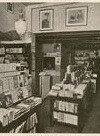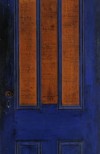Literary and Cultural History Preserved in Wood, Paint, Ink & Graphite
Literary, social and cultural history are all fascinatingly preserved in an old wooden door from a 1920s Greenwich Village bookstore. In Frank Shay’s Bookshop at 4 Christopher Street the proprietor was surprised one day in 1921 when writer Hedrik Willem Van Loon, an author with the publishing house of Boni & Liveright, signed his name to the door and for good measure added a little drawing to his contribution. Soon, Shay began routinely asking visiting writers and other cultural notables to sign the door. Ultimately, it would bear hundreds of signatures, including such figures of the day as John Dos Passos, Theodore Dreiser, Sinclair Lewis, Upton Sinclair, Sherwood Anderson, Heywood Broun, Christopher Morley, Edward Arlington Robinson, Frank Conroy, artist John Sloan, explorer Vilhalmur Stefansson, poet Don Marquis (creator of “The Adventures of Archy & Mehitabel”), and Henry Seidel Canby (editor, Saturday Review of Literature).
When the shop closed in 1925, the door was removed from the premises before the contents were auctioned to pay creditors. In subsequent decades its value as a cultural artifact became evident, with this advertisement appearing thirty-five years later: “Mrs. Frank Leon Smith has a door for sale. On the door are the autographs of about sixty people who in the early Twenties were important, famous, talented, unusual. Im [sic] telling you, this is a fabulous door….Want a door? Ask Mrs. Smith at 321 East 52nd Street, New York 22. —’Trade Winds’ in the Saturday Review, 1960”. Note that money would evidently not have been required to become custodian of the door.
Eventually, by steps unknown, the door reached the Ransom Center at the University of Texas in Austin, where it is housed today. Organizers there have created a terrific website devoted to it, to the shop, to Greenwich Village, and the period that produced it. Jennifer Scheussler’s New York Times Book Review article in September, with a neat slideshow, alerted me to the door’s colorful history and I’ve visited the Ransom website many times since. I love that Van Loon’s spontaneous signature became an inspiration for hundreds of contemporaries, all eager to scribble on a plank of wood, leaving a small imprint of their existence. It’s a veritable time capsule, or even better, a time machine taking us back to bookselling and publishing ninety odd years ago.


